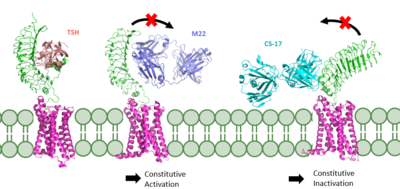Sandbox Reserved 1775
From Proteopedia
(Difference between revisions)
| Line 12: | Line 12: | ||
== Blocking TSHR in Active/Inactive States == | == Blocking TSHR in Active/Inactive States == | ||
| - | [[Image:conformation1.png|400px|right|thumb| | + | [[Image:conformation1.png|400px|right|thumb|TSHR in active and inactive binding states. '''Left''' is THS bound to TSHR. '''Right''' is M22 bound to TSHR. '''Left''' is CS-17 bound to TSHR.]] |
The interactions between the ligand and the receptor have important consequences for disease states. In the image shown to the right are three different states of TSHR. The right-most structure is TSH bound to TSHR and is in it's upright active conformation. Comparing this is M22, shown in the middle, TSH binding offer not steric hinderance to keep it from being released. M22 can manifest with elevated levels of thyroid hormones which could be found in a person with Graves disease. M22 bound to TSHR is in the upright state and prevents transition to the down state because of the steric clash with the membrane which causes constitutive activation and symptoms of Graves disease. On the right most side is CS-17 bound to the TSHR. In contrast to TSH and M22 binding, CS-17 binds and locks TSHR in the down, inactive conformation. This prevents the signaling cascade to translation and causes constitutive inactivation. | The interactions between the ligand and the receptor have important consequences for disease states. In the image shown to the right are three different states of TSHR. The right-most structure is TSH bound to TSHR and is in it's upright active conformation. Comparing this is M22, shown in the middle, TSH binding offer not steric hinderance to keep it from being released. M22 can manifest with elevated levels of thyroid hormones which could be found in a person with Graves disease. M22 bound to TSHR is in the upright state and prevents transition to the down state because of the steric clash with the membrane which causes constitutive activation and symptoms of Graves disease. On the right most side is CS-17 bound to the TSHR. In contrast to TSH and M22 binding, CS-17 binds and locks TSHR in the down, inactive conformation. This prevents the signaling cascade to translation and causes constitutive inactivation. | ||
These different ways to active and inactive TSHR could represent potential therapies for someone with graves disease or other thyroid related diseases with overacting TSH binding. Whereas current therapies target T3/T4 synthesis or destroy the gland using artificial hormones. These diseases could instead be targeted with something like M22 or CS-17 | These different ways to active and inactive TSHR could represent potential therapies for someone with graves disease or other thyroid related diseases with overacting TSH binding. Whereas current therapies target T3/T4 synthesis or destroy the gland using artificial hormones. These diseases could instead be targeted with something like M22 or CS-17 | ||
Revision as of 23:04, 2 April 2023
| This Sandbox is Reserved from February 27 through August 31, 2023 for use in the course CH462 Biochemistry II taught by R. Jeremy Johnson at the Butler University, Indianapolis, USA. This reservation includes Sandbox Reserved 1765 through Sandbox Reserved 1795. |
To get started:
More help: Help:Editing |
Your Heading Here (maybe something like 'Structure')
| |||||||||||

